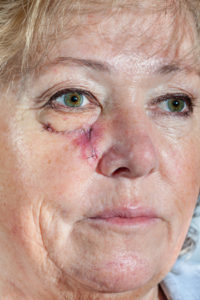![]()
Tampa
(813) 971-3846
![]()
Tampa
(813) 971-3846
 It seems that some form of cancer diagnosis within your lifetime is just about unavoidable, though certain cancers are worse than others. Every single day in America, more than 8,500 people are diagnosed with skin cancer, and it is estimated that one in five Americans will develop skin cancer in their lifetime. The only good news about such frightening statistics is that technology is now advanced enough to successfully combat cancer and keep it away for good.
It seems that some form of cancer diagnosis within your lifetime is just about unavoidable, though certain cancers are worse than others. Every single day in America, more than 8,500 people are diagnosed with skin cancer, and it is estimated that one in five Americans will develop skin cancer in their lifetime. The only good news about such frightening statistics is that technology is now advanced enough to successfully combat cancer and keep it away for good.
Types of Skin Cancer
There are three chief types of skin cancers: squamous cell carcinoma (SCC), basal cell carcinoma (BCC), and melanoma. The first two types are malignant, meaning they are dangerous, but they don’t pose the threat of spreading to the rest of the body. A smaller number of skin cancers are categorized as malignant melanoma, which is an incredibly aggressive type of cancer that spreads to other body parts and causes death if not treated very early.
The Mohs Surgery Procedure
Mohs surgery was developed by Dr. Frederick Mohs in the 1930s, and nearly 100 years later it is still considered the gold standard in skin cancer treatment. This is because Mohs is seen as the most effective technique for removing BCC and SCC skin cancers. The procedure manages to keep the most healthy tissue intact while completely eliminating cancer cells, and the cure rate with Mohs is at least 98 percent! That high of a cure rate is practically unheard of in cancer treatment.
How It Works
Mohs surgery isn’t done all at one time, but rather in stages in response to lab results. A specially trained Mohs surgeon uses a scalpel to remove the thinnest possible layer of cancerous tissue, then tests the sample to check for any remaining cancer cells. If they are still present, he will take another layer of tissue from the locations where cancer cells remain. This process may only need to be completed once or twice, or it could happen 5 or 6 times.
Depending on the amount of skin tissue taken off, reconstruction might be necessary to return the skin to its normal appearance. This typically involves taking skin tissue from another part of the body and placing it in the treated area to retain the natural appearance of the face. It’s a standard procedure, so there’s no need to worry! Believe it or not, everything can be completed in one easy visit. If Mohs surgery is done near the eye, and eye specialist should be responsible for the reconstruction to ensure that the eye is not harmed during the process.


Phone: (813) 971-3846
Office Hours:
Mon - Fri: 8am - 5pm
5379 Primrose Lake Cir
Tampa, FL 33647
(Inside the office of The Bowman Institute for Dermatologic Surgery)
Phone: (813) 971-3846
©Copyright 2015 J. Justin Eyelid Institute All Rights Reserved.